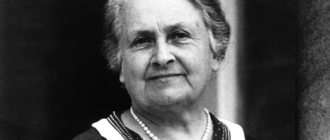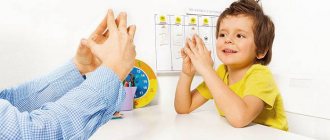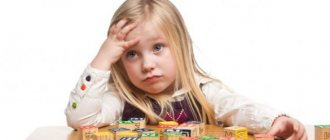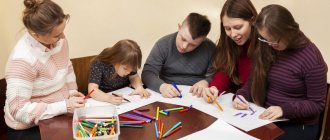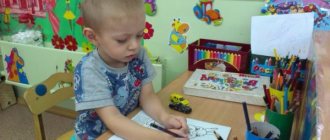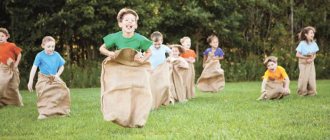According to Maria Montessori's periodization of development, the peak of activity in a variety of directions occurs in children precisely at the age of 2 to 3 years. Kids actively master speech and movement, learn to interact with a variety of objects, learn patterns and become sensitive to order, and also begin to expand their circle of acquaintances and make their first friends.
All this means that it is at this age that it is important to arrange for children all kinds of activities and games for harmonious development.
The motto of the Montessori philosophy is: “Help me do it myself.” The task of adults is to inspire children to make independent discoveries and achievements, because our little ones can do much more than it seems at first glance.
When planning Montessori activities for children 2-3 years old, you should adhere to the following rules:
- Classes should be aimed at increasing the child’s independence,
- Use different senses
- Include elements useful for the development of fine and gross motor skills,
- Take into account the interests of the child and use only at his request,
All Montessori activities should be presented to the child in advance, located in a place accessible to him (on a low shelf) and be accessible without the help of adults (however, exercises with small objects should be offered only when you have time to monitor the baby).
Montessori classes to develop a sense of order for children 2-3 years old
Such exercises help the child understand the principles by which our world exists; mainly here we work on sorting and classification.
Find a pair - Montessori classes for 2-3 years old
The principle of pair selection can be very widely used in working with children:
- Invite your child to sort his own socks and gloves.
- Print out images of animals and offer to compare the picture with existing toy models (the same can be done with your favorite cars, flowers, building models, etc.)
- Offer to find paired cards (colors, images, textures),
- Use special Montessori materials for 2 years and older
Sorting – complicated Montessori games for children from 2 years old
When the baby has mastered pairs, you can move on to a more complex option - sorting.
- Sort cards of different shades by color (you can cut pictures from magazines, scraps, colored cardboard, or you can buy a ready-made Montessori set),
- Remember Cinderella and offer to sort out different types of cereals. First, it is better to take larger grains: beans, chickpeas. Children's breakfast cereals with their cereals, pillows and rings can also be convenient,
- Sort out the box with grandma's buttons by shape, color or number of holes (you definitely have one!)
- Ask your child to put the cutlery in its place,
- Offer to clean up the kitchen and put all the cylinders and balls in one direction, and the cubes and parallelepipeds in the other,
- Rewind the salad: cucumbers to cucumbers, tomatoes to tomatoes, and so on
Establishing Montessori Sequences for a Child 3 Years and Under
- Lay out cards with simple stories and ask your child to remember the correct sequence of events.
- Use Montessori cylinders to help your child master the concepts of less-more and lower-higher,
- Learn simple self-care steps, breaking them down into steps. This way you can learn how to brush your teeth, take a shower, care for animals, and get ready for kindergarten.
Exercises related to social life
These exercises can help the child master a variety of forms of behavior in society. They should be carried out as group exercises, because types of social behavior can only be learned and realized in joint games with others. Conversation and role-play are suggested as suitable forms of exercise. To choose from the life of a child in a group, for example: A guest arrives. I'm going to visit. I give something. I would like to take part in the game. Forms of greeting. Goal: to draw the child’s attention to the forms of greeting for their meaningful use. Age: about three years. Conversation and role play. The child and the teacher are having a conversation about greetings. At the same time, it is proposed to raise the following questions: what forms of greeting do we know? • depending on the time of day; • depending on kinship and relationships between people (parents, brothers and sisters, relatives, friends, neighbors); • depending on the location (house, street). What is expressed through a greeting: • a person is recognized; • would like to make contact with the person; • people listen to each other. • Our commonly used forms of greeting are linguistically very shortened, for example: “Good afternoon!”, “Hello,” etc. The child goes through his own forms of greeting. The child's ideas and suggestions are implemented in role-playing games. It is important for the child to fill these forms with original content and their own ideas. Through the variety of possibilities of language, facial expressions and gestures, it is necessary to show patterns of behavior in various situations.
Montessori classes for the development of fine motor skills for 2-3 years
Little hands still don’t obey as well as adults, but finger coordination is the key to brain development. That is why fine motor skills are given great attention in preschool pedagogy.
Simple lacing is an excellent Montessori activity for children aged 2 years and older.
- Did your parents buy new shoes? First, ask your child to sort out the lacing. Children's shoes may be too small to be familiar with laces, so older ones may help.
- You can purchase a beautiful Montessori set for mastering lacing,
- Make beads or a bracelet from cord and large wooden beads,
- Master weaving craft with your child: weave a rug from large scraps, or maybe you have enough patience for a whole bag,
Pouring water and playing with small objects - Montessori activities that delight children 2-3 years old
- Don't be afraid to encourage children to pour their own water from the jug. Yes, perhaps several glasses will end up on the floor, but after a couple of times the baby will master this task without any problems and will be able to maintain the drinking regime himself (do not forget to offer the child a rag or mop in case water spills),
- Make the most of bath time: children can spend hours fiddling around in the bathtub with molds and toys, and this activity is extremely beneficial for their development,
- Pour small cereal into a bowl, give the child a spoon or scoop and offer to pour it into another container (the width of the neck will determine the difficulty of the whole activity),
- Invite your child to sort small objects (coins, pom-poms, peas, shells or pebbles) using tweezers,
Introducing literacy and mathematics - interesting Montessori activities for children 3 years old
If your child is already starting to show an interest in letters and numbers, the games presented below can be a great start to learning to read and write.
- Create letter and number bags filled with cereal and other fillings. With the help of these bags you can look for the first letters in words and come up with different games that introduce your child to phonetics,
- Make a couple of sets of cards with letters and numbers and use matching tasks,
- For learning to write, reusable outlines of letters can be useful; they can be traced with finger paints, plasticine and, when the hand is ready, with a pen,
- You can also make images of letters and numbers with a rough surface: this can be done with glue and sand. So the child will quickly remember the outlines of the symbols,
- Sets are great for learning to count, where you can select the required number of objects or dots for each number. This is necessary so that the child understands the meaning of numbers from the very beginning.
Personalized cleaning products for your baby
An integral part of the Montessori system is providing the child with the opportunity to clean up after himself. Give your child a cloth, a sponge, a small mop, a brush and a dustpan for his own use so that he can clean up spilled grain or spilled water during play. Let cleaning products always be in a place specially designated for them. There must be a trash basket in the baby's room.
Development of the senses through Montessori activities at 2 years and older
- Collect objects of different sizes, shapes and textures in an opaque bag and invite your baby to recognize them by touch.
- Get musical instruments and Montessori sound cylinders: teach your baby to feel the rhythm and pitch of sound, offer to choose pairs, distribute sounds in order,
- An excellent exercise for the development of visual analyzers will be the free work of children with creative materials: gouache, finger paints, watercolors, colored sand, plasticine,
- Sometimes you can find slimes and all kinds of jellies in children's stores; they can also be used to diversify the sensory experience.
Montessori games for 2 years old to gain independence at home
These exercises should rather be called a rational organization of space for children, which will help them master all the actions of caring for themselves and their things as quickly as possible:
- Help your child learn to dress independently: you can hang a funny diagram on the wall, you can make stickers on clothes and shoes that will help the child find the right side,
- Place on one tray everything you need to tidy yourself up when you wake up and before bed: comb, toothbrush, toothpaste, glass of water. Let the baby use all these items himself first, and then, if necessary, provide assistance.
- Some particularly stubborn fasteners can be attached to a work surface and create a kind of busy board on which the child can practice skills, so that later buttons and zippers do not cause problems for the child,
- At the same age, it is worth teaching your child to wash his hands with soap correctly; hang a reminder on the door or choose a rhyme that will remind the child to wash his hands after going outside and using the toilet.
According to the Montessori method, children aged 2 years can begin to be assigned general household chores.
- Teach your child how to use a spray bottle and offer to wipe the windows (make sure they are securely closed!) or the mirror. Make sure that your child does not come into contact with aggressive household chemicals,
- At the same age, you can teach your child to wash dishes - first, just rinse plates and cups in water, and then use a sponge,
- Sorting laundry is a great task for children: ask your little one to separate whites from colours, cottons from wool, or simply distribute the laundry into several baskets,
- The baby can start setting the table for himself. To learn the location of cutlery and utensils, you can offer your child a special rug with silhouettes, it will also protect the table from dirt,
- Allow your child to participate in making your home cozy: let him put flowers in a vase, put away pets’ bowls, sweep the floor with his own small broom, arrange photo frames,
- It is useful for the development of gross motor skills to invite the child to lay out the carpet every time he wants to play on the floor, and to roll it up when the game is finished. Make sure that the mat is not too heavy for the child.
Metal cleaning
Materials: mat on a tray, liquid metal cleaner in a bottle, a drawer with cotton balls or pieces of sandpaper, a cup each for dirty cotton wool and a small amount of cleaner, a polishing cloth, a not too small brass object without decoration. Goal: development of coordination of movements. Cleaning metal objects. Age: about three years. How to work with the material. The teacher prepares the workplace with the child. Starting together can give the child extra incentive to do the exercise. All objects that the child needs must be within his field of vision. First of all, the teacher pushes a small bottle of cleaning product. At the same time, he holds onto the lid. A large bottle would be an additional difficulty for the child. He places the bottle on the mat, unscrews the cap and places it bottom down. She pours a small amount of cleaning product into a cup, caps the bottle, and places it back on the tray. Interesting point! Opening, closing, pouring, screwing. In addition, this prevents the bottle from tipping over. Using a cotton ball, the teacher takes a dark cleanser from the cup, shows the child a small amount of the cleanser on the cotton ball, and spreads it in slow and careful circular motions over the surface of the item. Dirty cotton wool is placed in a prepared cup. It is especially difficult to use not too much and not too little cleaning product. While the cleaning product is waiting to work, the teacher pours the remaining product back into the bottle and closes it again. He then takes a cotton swab and wipes the cleaning agent off the surface of the brass object and shows the child the dirt on the cotton. This process is repeated until the cotton wool is clean. Interesting point! The teacher takes a polishing cloth and rubs the surface of the object until it shines, shows the object to the child, conducts the exercises without interruption, with slow precise movements and with obvious interest in the matter. In this way, the child is given the opportunity to learn the course of actions in connection, clearly understand individual actions and pay attention to the matter as a whole. The teacher invites the child to repeat the exercise with another thing and watches him. After some time, you can move away, but continuously maintain contact with the working child. When the activity is finished, the teacher shows how to clean up and put away the required material. Only after cleaning is the exercise considered completed. Further exercises: complicate the exercise with the help of small, deformed or decorated objects. New objects or tools for work can help the child maintain interest in the activity longer. Error control: dirty polishing cloth, shiny thing. Application: cleaning door handles, cutlery.
conclusions
The Montessori method for children from 2 years old offers a huge selection of activities and allows you to adapt to the interests and character of each child. For the harmonious development of the baby, try to offer your child activities from different blocks, and also make sure that the child always has a choice of what to do.
Any tasks proposed here can be adapted to suit any child. An active fidget can be asked to run around the entire yard in search of objects on cards, and a slow homebody can from time to time make the task easier and bring materials in a basket. A technology lover will find it more interesting to find pairs for cars of different colors, and a wildlife lover will be happy to work on sorting images with animals and plants.
Always make sure your child is satisfied and never force you to complete tasks. Only thanks to internal motivation will the child’s cognitive and emotional development develop successfully.
Pros and cons of the system
Like any system, the Montessori method has opponents and admirers. It will be easier for most people to figure out which group they belong to after they become familiar with the pros and cons of the system.
pros
Among the advantages of the system are:
- the adult has virtually no influence on the development of children or makes only minor interference, which allows the child to master the world without imposed prejudices;
- the technique allows children to express themselves and takes into account individual characteristics;
- children are not forced, but motivated to learn, they are not praised, but they are not scolded either, so the learning process is not so traumatic;
- children gain freedom, independence and develop the ability to independently plan and organize their activities;
- the system takes into account the periods of children's development, improves fine motor skills, develops senses;
- quickly instills skills of self-service, responsibility, and self-control;
- develops intelligence, speech, logical and analytical thinking;
- gives an idea of world realities and contacts with other people (if the child is brought up according to this system and in a group).
There is no need to set aside any time to use the Montessori system. The beauty of this technique is that you don’t do it periodically, but live in it. Moreover, this form of living is quite convenient for adults. Children develop themselves at a pace that is convenient for them, and the adult’s task is to provide the baby with everything necessary and monitor his safety. In addition, this technique is “inexpensive”. All equipment is inexpensive, especially if you make it yourself.
Minuses
The method also has some drawbacks:
- greater emphasis on the intellectual side of the child’s development to the detriment of his emotionality and creative inclinations;
- ignoring role-playing games, arguing that they distract the child;
- omissions related to the temperamental characteristics of children (not all children will ask for help, and not everyone will be interested);
- the methodology is fundamentally different from the methods of education and presentation of material in kindergartens and schools, which creates difficulties for the child in adapting to the school schedule and the peculiarities of interaction with teachers;
- lack of physical activity.
Given these shortcomings, classical Montessori is rarely implemented in its “pure” form. More active games and elements of control over the child’s activities are added to it, so that it is easier for him to socialize in educational institutions.
